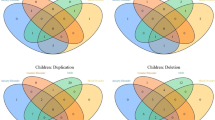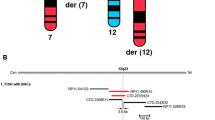Abstract
Deletions in chromosome 17q12 encompassing the HNF1β gene cause cystic renal disease and maturity onset diabetes of the young, and have been recently described as the first recurrent genomic deletion leading to diabetes. Earlier reports of patients with this microdeletion syndrome have suggested an absence of cognitive impairment, differentiating it from most other contiguous gene deletion syndromes. The reciprocal duplication of 17q12 is rare and has been hypothesized to be associated with an increased risk of epilepsy and mental retardation. We conducted a detailed clinical and molecular characterization of four patients with a deletion and five patients with a reciprocal duplication of this region. Our patients with deletion of 17q12 presented with cognitive impairment, cystic renal disease, seizures, and structural abnormalities of the brain. Patients with reciprocal duplications manifest with cognitive impairment and behavioral abnormalities, but not with seizures. Our findings expand the phenotypic spectrum associated with rearrangements of 17q12 and show that cognitive impairment is a part of the phenotype of individuals with deletions of 17q12.
Similar content being viewed by others
Log in or create a free account to read this content
Gain free access to this article, as well as selected content from this journal and more on nature.com
or
References
Lupski JR, Stankiewicz P : Genomic disorders: molecular mechanisms for rearrangements and conveyed phenotypes. PLoS Genet 2005; 1: e49.
Bellanne-Chantelot C, Clauin S, Chauveau D et al: Large genomic rearrangements in the hepatocyte nuclear factor-1beta (TCF2) gene are the most frequent cause of maturity-onset diabetes of the young type 5. Diabetes 2005; 54: 3126–3132.
Ulinski T, Lescure S, Beaufils S et al: Renal phenotypes related to hepatocyte nuclear factor-1beta (TCF2) mutations in a pediatric cohort. J Am Soc Nephrol 2006; 17: 497–503.
Decramer S, Parant O, Beaufils S et al: Anomalies of the TCF2 gene are the main cause of fetal bilateral hyperechogenic kidneys. J Am Soc Nephrol 2007; 18: 923–933.
Faguer S, Bouissou F, Dumazer P et al: Massively enlarged polycystic kidneys in monozygotic twins with TCF2/HNF-1beta (hepatocyte nuclear factor-1beta) heterozygous whole-gene deletion. Am J Kidney Dis 2007; 50: 1023–1027.
Mefford HC, Clauin S, Sharp AJ et al: Recurrent reciprocal genomic rearrangements of 17q12 are associated with renal disease, diabetes, and epilepsy. Am J Hum Genet 2007; 81: 1057–1069.
Lu X, Shaw CA, Patel A et al: Clinical implementation of chromosomal microarray analysis: summary of 2513 postnatal cases. PLoS ONE 2007; 2: e327.
Ou Z, Kang SH, Shaw CA et al: Bacterial artificial chromosome-emulation oligonucleotide arrays for targeted clinical array-comparative genomic hybridization analyses. Genet Med 2008; 10: 278–289.
Probst FJ, Roeder ER, Enciso VB : Chromosomal microarray analysis (CMA) detects a large X chromosome deletion including FMR1, FMR2, and IDS in a female patient with mental retardation. Am J Med Genet A 2007; 143A: 1358–1365.
Mencarelli MA, Katzaki E, Papa FT et al: Private inherited microdeletion/microduplications: implications in clinical practice. Eur J Med Genet 2008; 51: 409–416.
Zhao Y, Kwan KM, Mailloux CM et al: LIM-homeodomain proteins Lhx1 and Lhx5, and their cofactor Ldb1, control Purkinje cell differentiation in the developing cerebellum. Proc Natl Acad Sci USA 2007; 104: 13182–13186.
Kania A, Johnson RL, Jessell TM : Coordinate roles for LIM homeobox genes in directing the dorsoventral trajectory of motor axons in the vertebrate limb. Cell 2000; 102: 161–173.
Shawlot W, Behringer RR : Requirement for Lim1 in head-organizer function. Nature 1995; 374: 425–430.
Acknowledgements
We thank the participating families for their kind cooperation. This work was supported in part by fellowship grants from the Osteogenesis Imperfecta Foundation (SNSC), DK081735-01A1, NIH/NIGMS T32 contract grant number GM07526 and by the National Urea Cycle Foundation Research Fellowship (AE), and grant R13-0005-04/2008 from the Polish Ministry of Science and Higher Education (PS).
Author information
Authors and Affiliations
Corresponding author
Rights and permissions
About this article
Cite this article
Nagamani, S., Erez, A., Shen, J. et al. Clinical spectrum associated with recurrent genomic rearrangements in chromosome 17q12. Eur J Hum Genet 18, 278–284 (2010). https://doi.org/10.1038/ejhg.2009.174
Received:
Revised:
Accepted:
Published:
Issue date:
DOI: https://doi.org/10.1038/ejhg.2009.174
Keywords
This article is cited by
-
The HNF1B mutations and deletion associated with diabetes and their resulting diabetic phenotypes: a systematic review
International Journal of Diabetes in Developing Countries (2024)
-
Purtscher-like retinopathy in a 19-year-old with maturity-onset diabetes of the young: a case report
Journal of Medical Case Reports (2023)
-
Fetal congenital gastrointestinal obstruction: prenatal diagnosis of chromosome microarray analysis and pregnancy outcomes
BMC Pregnancy and Childbirth (2023)
-
Clinical findings and genetic analysis of patients with copy number variants involving 17p13.3 using a single nucleotide polymorphism array: a single-center experience
BMC Medical Genomics (2022)
-
A rare combination of MODY5 and duodenal atresia in a patient: a case report
BMC Medical Genetics (2020)



